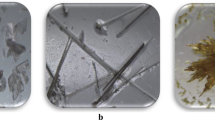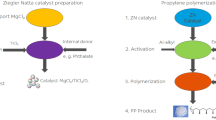Abstract
Oligomeric aliphatic poly(amides) (PAs) with phthalimide or tetrahalophthalimide were obtained from aspartic and glutamic acids which reacted previously with phthalic or tetrahalophtalic anhydrides, and the diamine bis(4-aminophenyl)-diphenylsilane, by direct polycondensation according to the Yamazaki method. PAs were characterized by IR and 1H, 13C and 29Si NMR, inherent viscosity measurements and optical activity. The results showed low η inh values due to the insolubility of the PAs in the reaction media. All PAs were soluble in aprotic polar solvents and partially soluble in other common solvents as CHCl3 and THF. The T g values for the PAs derived from aspartic acid showed an increase when the size of the halogen atom is increased due to the more rigidity of the imide group. For those PAs derived from glutamic acid the influence of the side groups was less important due probably to the higher influence of the longer aliphatic main chain. The thermal degradation analysis showed that PAs have good TDT values with the exception of PA-7. The temperature for 50 % of weight loss for both PAs series was dependent on the nature of the halogen, showing an increase when the halogen was more electronegative. PAs do not showed good optical properties, with the exception of PA-1 and PA-6 without halogen atoms in the side chain, due to the increase of the volume of the side group which affects their mobility increasing their packing. It is possible to see a low increase of the transmittance when the aliphatic chain is increased from aspartic to glutamic acid due to an increase of the flexibility of the main chain.


Similar content being viewed by others
References
Mallakpour S, Kowsari E (2005) Synthesis and characterization of new optically active poly(amide-imide)s containing epiclon and l-methionine moieties in the main chain. Polym Adv Technol 16:732. doi:10.1002/pat.648
González-Henríquez CM, Tagle LH, Terraza CA, Leiva A, Barriga Gonzalez A, Volkmann UG, Cabrera AL, Ramos-Moore E, Pavez-Moreno M (2012) Thiophene- and silarylene-containing polyesters. Resonance effect on conductivity after polarization in an external electric field. Polym Int 61:810. doi:10.1002/pi.4147
Tagle LH, Terraza CA, Ortiz P, Rodriguez MJ, Tundidor-Camba A, Leiva A, Gonzalez-Henriquez CM, Cabrera AL, Volkmann UG, Ramos-Moore E (2012) Synthesis of oligomeric silicon-containing poly(imide-amide)s derived from trimellitic anhydride and amino-acids. Vibration spectral, optical, thermal and morphological characterization. J Macromol Sci Part A Pure Appl Chem 49:562. doi:10.1080./10601325.2012.687963
Liaw DJ, Liaw BY (2001) Synthesis and characterization of new polyamide-imides containing pendent adamantyl groups. Polymer 42:839. doi:10.1016/s0032-3861
Nakata S, Brisson J (1997) Preparation of aromatic copolyamides containing regularly placed 1,6-hexamethylenediamine units. J Polym Sci Part A: Polym Chem 35:2379. doi:10.1002/(SICI)1099-0518(19970915)
Liaw DJ, Hsu PN, Liaw BY (2001) Synthesis and characterization of novel polyamide-imides containing noncoplanar 2,2′-dimethyl-4,4′-biphenylene unit. J Polym Sci Part A Polym Chem 39:63. doi:10.1002/1099-0518(20010101)
Tagle LH, Terraza CA, Villagra H, Tundidor-Camba A (2011) Poly(imide-amide)s and poly(imide-ester)s base don silarylene units containing (l)-alanine moiety: synthesis and characterization. Polym Bull 67:1799. doi:10.1007/s00289-011-0507-y
Tagle LH, Terraza CA, Leiva A, Yazigi N, Lopez L (2010) Poly(imide-amides) and poly(imide-ester)s obtained from N,N′-(4,4′Me,R-diphthaloyl)-bis-glycine acid dichloride (R=Me, Et): synthesis, characterization and thermal studies. J Appl Polym Sci 117:1526. doi:10.1002/app.32007
Tagle LH, Terraza CA, Leiva A, Coll D (2012) Silicon-containing oligomeric poly(amides) with phthalimidyl-amide side groups: synthesis, characterization and thermal studies. High Perform Polym 24:77. doi:10.1177/0954008311431348
Mallakpour S, Zadahnazari A (2011) Advances in synthetic optically active condensation polymers—a review. eX Polym Lett 5:142–181. doi:10.3144/expresspolymlett.2011.15 (and the references therein)
Mallakpour S, Dinari M (2008) Microwave step-growth polymerization of 5-(4-methyl-2-phthalimidylpentanoylamino)isophthalic Acid with different diisocyanates. Polym Adv Technol 19:1334. doi:10.1002/PAT.1142
Mallakpour S, Taghavi M (2008) A facile, microwave-assisted synthesis of novel optically active polyamides derived from 5-(3-methyl-2-phthalimidylpentanoylamino)isophthalic acid and different diisocyanates. Eur Polym J 44:87. doi:10.1016/jeorpolymj.2007.10.027
Mallakpour S, Sepehri S (2008) Preparation of new optically active polyamides containing a l-phenylalanine, phthalimide side-chain via the diisocyanate route by microwave energy: comparison with conventional heating. Des Monomers Polym 11:535. doi:10.1163/156855508X363825
Sava I, Bruma M, Schulz B, Kopnick T (2005) Comparison of properties of silicon-containing poly(amide-imide)s. High Perform Polym 17:483. doi:10.1177/0954008305044162 (and the references therein)
Bruma M, Schulz B (2001) Silicon-containing aromatic polymers. J Macromol Sci 41:1. doi:10.1081/MC-1000002054
Tagle LH, Terraza CA, Valenzuela P, Leiva A, Urzua M (2005) Thermal studies of poly(esters) containing silicon or germanium in the main chain. Thermochim Acta 425:115. doi:10.1016/j.tca.2004.06.008
Tagle LH, Diaz FR, Vega JC, Valenzuela P (2003) Synthesis and characterization of poly(esters) derived from diacids and diphenols containing silicon and germanium. Eur Polym J 39:407. doi:10.1016/s0014-3057(02)00226-4
Mattern DL (1984) Direct aromatic periodination. J Org Chem 49:3051. doi:10.1021/jo00191a003
Sakhautdinov IM, Leont’eva NA, Galin FZ, Vafina GF (2008) Synthesis of pirrolizidine- and indolizinedione derivatives based on N-phthalylaspartic acid. Russ J Org Chem 44:1009. doi:10.1134/s1070428008070117
Yeganeh H, Ghasemi N, Taromi FA (2005) Synthesis and characterization of novel nonsegmented polyamides and polyurethanes with enhanced flame retardancy properties. Iran Polym J 14:539
Faghihi K, Absalar M, Hajibeygi M (2010) Synthesis and characterization of new optically active polyamides containing 2-(4-nitro-1,3-dioxoisoindolin-2-yl)succinic acid and aromatic diamines via direct polycondensation. Turk J Chem 34:81. doi:10.3906/kim-0811-4
Pratt JR, Massey WD, Pinkerton FM, Thames SF (1975) Organosilicon compounds. XX. Synthesis of aromatic diamines via trimethylsilyl protecting aniline intermediates. J Org Chem 40:1090. doi:10.1021/jo00896a021
Yamazaki N, Matsumoto N, Higashi F (1975) Studies on reactions of the N-phosphonium salts of pyridines. XIV. Wholly aromatic polyamides by the direct polycondensation reaction by using phosphites in the presence of metal salts. J Polym Sci Part A: Polym Chem 13:1373. doi:10.1002/pol.1975.170130609
Vikic D, Mintas M, Vorkpic-Furac J, Willard PG (1990) Carbon-fluorine coupling constants in C-13 NMR spectra of some substituted N-aryl-pyrroles. Bull Chem Technol Macedonia 9:119
Schwarzer A, Weber E (2008) Influence of fluorine substitution on the crystal packing of N-phenylmaleimides and corresponding phthalimides. Cryst Growth Design 8:2862. doi:10.2021(cg7011638
Terraza CA, Tagle LH, Tundidor-Camba A, Gonzalez-Henriquez C, Ortiz P, Coll D (2012) Poly(amide)s obtained from 4-(4-((4-(4-aminophenoxy)phenyl)phenyl)diphenyl-silyl)phenoxy)benzeneamine and dicarboxylic acids containing diphenylsilarylene units. Synthesis and characterization. Eur Polym J 48:649. doi:10.1016/j.eurpolymj.2012.01.007
Terraza CA, Tagle LH, Mejias D, Tundidor-Camba A, Ortiz P, Muñoz D, Alvarez F, Gonzalez-Henriquez CM (2013) Synthesis and characterization of new poly(amide)s derived from bis(4-(4-aminophenoxy)phenyl)-methylphenylsilane and bis (4-carboxyphenyl)R1R2silane acids. Polym Bull 70:773. doi:10.1007/s00289-012-0824-9
Acknowledgments
The authors acknowledge “Fondo Nacional de Investigación Científica y Tecnológica”, FONDECYT, through Project 1100015. A.T.C. acknowledges CONICYT for Ph.D. fellowship.
Author information
Authors and Affiliations
Corresponding author
Rights and permissions
About this article
Cite this article
Tagle, L.H., Terraza, C.A., Tundidor-Camba, A. et al. Oligomeric aliphatic/aromatic poly(amides) containing silicon in the main chain and phthalimide or tetrahalophthalimide moieties as side groups. Polym. Bull. 71, 287–300 (2014). https://doi.org/10.1007/s00289-013-1061-6
Received:
Revised:
Accepted:
Published:
Issue Date:
DOI: https://doi.org/10.1007/s00289-013-1061-6




